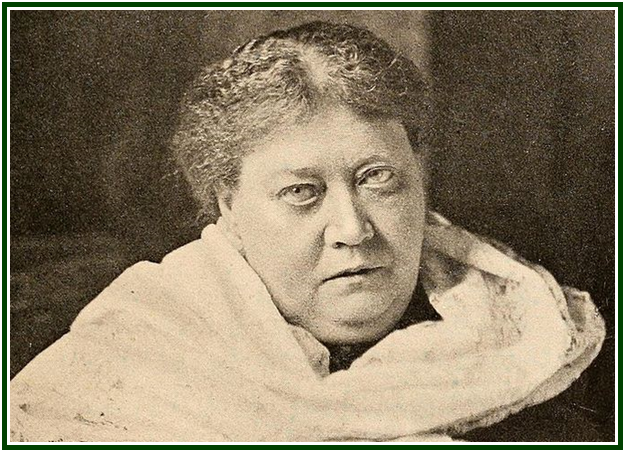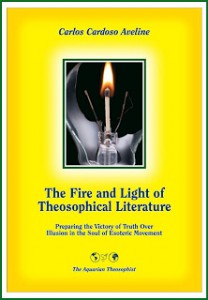
The Most Important Gift The
Russian Thinker Left to Mankind
Carlos Cardoso Aveline

Helena Blavatsky (1831-1891)
“I mean an intelligent word
graven in the soul of the learner…”
(Socrates, in “Phaedrus”, by Plato, folio 276)
The works written by Helena P. Blavatsky are among the most significant in the philosophical literature of all time. A bird’s eye view is enough to see it.
However, it would not be accurate to ascribe solely to HPB the merit for the literature she put on paper. She wrote in cooperation with raja-yogis of the Himalayas who have reached far beyond the present stage of human evolution.
It is the first time, in the last two thousand and five hundred years, that the eternal wisdom is taught in such a clear way. In quality and quantity, the writings of HPB are unparalleled in philosophical literature. Her teachings are more extensive and more revealing than those of Plato. They are more universal and comprehensive than the Talmud or the Upanishads. While their influence on the evolution and history of mankind has been subtle, it is enormous, as demonstrated by Sylvia Cranston in her book “HPB – The Extraordinary Life and Influence of Helena Blavatsky, Founder of the Modern Esoteric Movement”.[1]
And it is only natural to ask ourselves:
“What is the single most important work HPB left to mankind, as she went away in 1891?”
The true masterpiece of Helena Blavatsky is not “The Secret Doctrine”, nor “Isis Unveiled”. Her magnum opus is neither “The Voice of the Silence” nor “The Key to Theosophy”. It cannot be found in any of the 15 volumes with short texts that comprise her “Collected Writings”.[2]
The real masterpiece of HPB and her greatest gift to mankind is probably the very theosophical movement, seen as a living and collective magnetic process, that is, a social, a shared process of connection with the world of immortal soul.
It is a process combining research, teaching and learning. It is also a subtle vibratory field, a common space dedicated to the mutual help among learning souls. Being alive, the process is subject to the ups and downs of the tides governing everything that exists. It needs to go through moments of relative death, of profound defeat, and then undergo its resurrection, its rebirth and victory. It needs to go through the unpleasant experience of losing its way, before recovering and resuming its upward journey towards spiritual Light.
The written works of HPB, although admirable, were never a goal in themselves. Her writings are a practical instrument for humanity to better build the next stage of its evolutionary process. The books by Blavatsky are part of the theosophical movement. They are working tools for the theosophists, as they try to live and stimulate the birth of a new universal consciousness.
And at this point there is a central fact which many ignore.
The theosophical teaching can only be understood if it is examined from the point of view of the collective effort that HPB inaugurated, that is, from the point of view of the theosophical movement, whose goal is make it easier for humanity to free itself at least from the most grotesque aspects of spiritual ignorance, self-centered illusion and disrespect for life.
It is not enough, and it is relatively useless, therefore, to try to obtain the information present in the books by HPB, or even in the Letters of the Masters, and elegantly recite them while drinking tea with one’s friends. One must die internally to self-centered illusions, before realizing the deeper meaning of the theosophical teachings. The journey in this direction may be long, but the path is this one and no other. Little by little we can make real progress.
Francis of Assisi taught the most perfect theosophy when he said that “it is by dying that one is born to eternal life”. Because it is indeed by dying to ethical ignorance and to mere preoccupation with oneself that one is born to an understanding of theosophy, and to altruism.
The meaning of the best theosophical texts can only be understood if there is in the reader a lasting personal commitment to his own self-improvement, and to the improvement of the entire world. These two aspects of spiritual learning are inseparable, and they must occur through theosophical lodges.
The mirror, the example and encouragement given by others are fundamental to the pilgrim’s progress. As he faces the challenges and dangers of life, the student of theosophy has three main refuges. The first is the living source of wisdom which he gradually finds in his own soul. The second refuge is the authentic teaching, recorded in writing, which he can study individually and in groups. The third is the community of seekers, the Theosophical Lodge, whose convivial environment and whose common work allow him to test his learning in practice, taking lessons from his own failures and from the failures of others, and also from victories.
The three refuges are essentially inseparable.
Individual awakening can only happen if it is in unison with the awakening of the world. It can only occur through an organically altruistic effort. A theosophical lodge that is pedagogically conscious and also centered on authentic theosophy is the environment in which the alchemical transformation of egocentric lead into the gold of altruistic fraternity can take place.
The real theosophical movement is, in reality, a practical school of philosophy. It is “a pedagogy in movement”. It allows us to bring into daily life, in the 21st century and following centuries, the ethical, mystical and philosophical teachings of all times. It provides the interpretation keys that allow us to better understand the different cultural and religious traditions.
Wisdom transcends words.
The writings are useful. Correct words are sacred. But they can only point in the direction of wisdom.
The theosophical movement, whenever it has common sense, is the realm of research and learning in which the sacred words are tested in practice and transformed into action. That is why it constitutes in itself a living nucleus for improving human life from within. Such a nucleus has the privilege of actively participating in the preparation of the next stages of humanity.
The Lodge as a Laboratory
Among the different international schools of theosophical thought, the Independent Lodge of Theosophists occupies a pioneering position. It belongs to that (so far) small lineage that can already recognize the teaching of the Letters of the Mahatmas and the writings of HPB as the great key and the central priority of the movement [3]. For this reason, the Independent Lodge does not follow any of the more bureaucratic lineages of the movement, created by Annie Besant and William Q. Judge.
The true masterpiece of HPB is not hers alone. It is not fully written or published on the Internet or on paper. Every sincere student in any country can be its co-author. It is within his power to create it and to keep it alive in his own daily existence.
The masterpiece must be written in the soul, as Plato taught. It must be permanently edited. Every earnest student is able to grasp the living force of the selfless writings of Blavatsky and the Letters of the Masters. He can record them every day in his existence and in his own spirit. And this he achieves as he works to make his theosophical lodge an effective alchemical laboratory, dedicated to the practical production of the gold of Brotherhood with Discernment.
NOTES:
[1] See part seven of the book “HPB – The Extraordinary Life and Influence of Helena Blavatsky, Founder of the Modern Esoteric Movement”. A Jeremy P. Tarcher / Putnam Book, published by G.P. Putnam’s Sons, New York, copyright 1993, 648 pp.
[2] Volume XV is the cumulative index; and another volume translates her Russian language articles: “From the Caves and Jungles of Hindostan”. All edited by Boris de Zirkoff and published by the TPH, USA.
[3] See “The Prehistory of an Independent Lodge” and “Profile of the Independent Lodge”.
000
“The Masterpiece of Helena Blavatsky” is a translation from the Portuguese language article “A Obra-Prima de H.P. Blavatsky”. Its initial version was anonymously published in the November 2009 edition of the monthly journal “O Teosofista”. It was first published in English in August 2016, and updated by the author in June 2024.
000
On the role of the esoteric movement in the ethical awakening of mankind during the 21st century, see the book “The Fire and Light of Theosophical Literature”, by Carlos Cardoso Aveline.

Published in 2013 by The Aquarian Theosophist, the volume has 255 pages and can be obtained through Amazon Books.
000